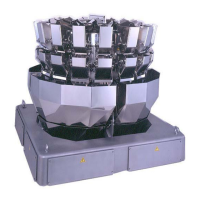8 OPTIONAL FUNCTIONS CCW-R-2**B INSTRUCTION MANUAL
8-2
8.2 Parent and Child Weighing
Parent and child weighing is a weighing method that performs mix weighing by discharging the product
of a certain weigh head (parent head) without fail.
• Heads other than the parent head are referred to as “child head”.
When performing the parent and child weighing, mechanical measures must be taken to prevent the product
weighed by the parent head from mixing with products weighed by child heads.
8.2.1 Types of Parent and Child Weighing
The parent and child weighing is a weighing method that performs mix weighing based on the parent
head weighing results, while the standard mix weighing is based on the combination results of each
weighed product.
There are two types of parent and child weighing: “Parent and child mix weighing” and “Bonus adding”.
8.2.1.1 Parent and Child Mix Weighing
“Parent and child mix weighing” is a weighing method in which the parent head weight is included into
the target weight (the parent head participates in the combination weighing).
The device first weighs the product in the parent head. The target weight for child heads is calculated
based on the parent head weight.
Target weight for child heads = Target weight - Parent head weight
Example: When the target weight is 200.0g and the parent head weight is 30.5g, the target weight for
child heads will be:
200.0-30.5 = 169.5 (g)
The combination weighing will be performed with the child head target weight set to 169.5g.
The discharged product weight will be the sum of the combination weighing result with the child head
target weight of 169.5g, and the parent head weight.
For instance, when the combination weighing result of the child head is 170.5g, the discharged product
weight will be 170.5+30.5=201.0(g).

